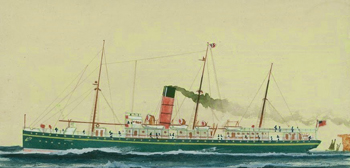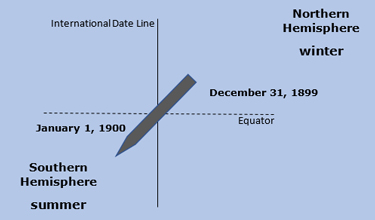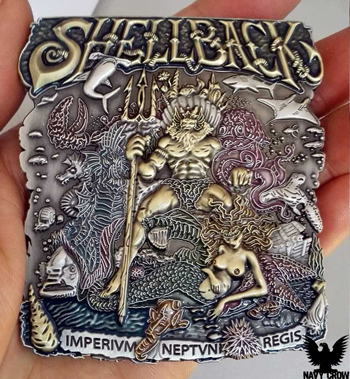SS Warrimoo: The Ship That Missed New Year’s Eve

Warrimoo is Aborigines meaning Eagle’s nest or Landing. Credit: Tourism Australia
The SS Warrimoo had 32 passengers and was halfway through her voyage while cruising in the middle of the Pacific Ocean on its way from Vancouver, Canada, to Sydney, Australia. The weather was calm and clear on the night of December 31, 1899. Capt. John Phillips was on the bridge puffing a cigar when the navigator completed a star fix and presented the figures, including the LOP—Line of Position—to the ship’s master. A wry smile crossed the captain’s face when he checked his ship’s position and informed the navigator and three of the crew that they were in for a special treat. It was midnight when Capt. Phillips called for the engine to stop, then checked and double checked the position and announced, “We’re here!” The steamship was resting on the Equator at exactly the point where it crossed the International Date Line. But the hearty master wasn’t through.

The SS Warrimoo made history on the night of December 31, 1899. Credit: Tourism Australia
Although Capt. Phillips and his crew completed what some call, “the navigational coup of a lifetime,” they never received any credit until more than 40 years later. The captain wasn’t a braggart and never notified the newspapers of his accomplishment. In 1942, a Canadian reporter doing research on “shellbacks,” the name given to Navy seamen and civilians who cross the equator, came across a tiny blurb in an early Australian newspaper that told about the Warrimoo’s “strange” experience. In 1953, writer John Euller popularized the story by writing more about it in Ships and the Sea Magazine. As word got out and garnered more publicity, some people started to question the story. They said the navigational instruments used in those days weren’t accurate enough to gather all the data to support the captain’s claims. They thought it foolish to deal with

The SS Warrimoo’s position on December 31, 1899. Credit: National Oceanic & Atmospheric Administration
Unfortunately, the steamship became a victim of “friendly fire” during World War I when it was in a convoy transporting British troops from Bizerta, Tunsisia, to Marseille, France. In May, 1918, she sank off the coast of Tunisia, North Africa, 12 miles southwest of La Galite Island after colliding with the French destroyer Catapulte. (Latin, French for “war machine for throwing”). During the collision, the Allied warship’s depth charges broke free and blew out the bottom plates of both vessels. Some lives were lost as the ships settled in deep waters.

Navy men and others who cross the equator become “Shellbacks.” Credit: U S. Navy
Note: “Shellbacks” (warriors) go back 400 years in maritime history. Originally Navy men and later civilians, they are welcomed by King Neptune and his court as the ship crosses the equator. There’s lots of hazing and crazy costumes as everyone celebrates the transformation of muddy pollywogs (someone who hasn’t crossed the equator) to a seafaring shellback and noble member of the court.
Author: Ellsworth Boyd
Ellsworth Boyd, Professor Emeritus, College of Education, Towson University, Towson, Maryland, pursues an avocation of diving and writing. He has published articles and photo’s in every major dive magazine in the US., Canada, and half a dozen foreign countries. An authority on shipwrecks, Ellsworth has received thousands of letters and e-mails from divers throughout the world who responded to his Wreck Facts column in Sport Diver Magazine. When he’s not writing, or diving, Ellsworth appears as a featured speaker at maritime symposiums in Los Angeles, Houston, Chicago, Ft. Lauderdale, New York and Philadelphia. “Romance & Mystery: Sunken Treasures of the Lost Galleons,” is one of his most popular talks. A pioneer in the sport, Ellsworth was inducted into the International Legends of Diving in 2013.
10 Comments
Trackbacks/Pingbacks
- Almost to New Zealand | Arteman's Blog - […] About about midday she crossed the International date line, you can read an interesting if unusual story about the…
Submit a Comment
All Rights Reserved © | National Underwater and Marine Agency
All Rights Reserved © | National Underwater and Marine Agency
Web Design by Floyd Dog Design
Web Design by Floyd Dog Design

Perfect tale as we head into New Years Day. Thanks!
Thanks, I’m glad you liked it. I stumbled upon the story while researching another ship. I had never heard of the SS Marrimoo and evidently neither had lots of others. It was an interesting story to write.
As always, Mr Boyd, a very entertaining read. Being in the right place at the right time certainly applies here. I’ve heard and read stories of mariners of days gone by who accomplished amazing feats by dead reckoning or with the use of a compass and sextant–think of Ernest Shackleton. I can believe that Capt. John Phillips managed to position his craft on the International Dateline at midnight given the circumstances that you describe.
Rick: Thanks for your comment. I agree with your opinion. In addition, If the weather had been questionable I might have doubted the story, but it was perfect and the captain had full control of his ship. And he had witnesses as well. Yes, good points you made about shackleton and Phillips. Also, we can’t underestimate the better navigators of years passed. They may not have had the instruments we have today, but many of them were smart mariners. Thanks again.
Your illustration with the ship’s silhouette crossing the junction of the equator and International Date Line is helpful to understanding the story, but shouldn’t the date on the northeastern quadrant be December 30 instead of 31? According to the story, crossing the junction of the lines exactly at midnight would cause the people on board to skip December 31 entirely.
Good for you Bruce. Let me double check this. I think you may be correct. If so, I shall see if the webmaster can correct this. Many thanks. Cheers, Ellsworth
Bruce: Here is a very good comment from George:
The International Dateline is a confusing topic when we don’t confront it on a a regular basis. If the Warrimoo was at sea on the 31st, then I believe that the other side of he line was already Jan. 1 and the ship, upon stopping on the dateline, would actually be at the beginning of Jan 2nd and if I’m correct then it was actually Jan 1. that was missed.
Somewhere on the internet, there is probably a program that will help with this calculation. My model for this interpretation is based upon the annual celebration of New Year’s Day on TV. If memory serves me correctly, the program always shows Australia having celebrated the big night hours before our morning news broadcast. Therefore they would be entering Jan 2 when we celebrate Jan. 1 at midnight.
If you have a globe at home with a time reference disc at the top axis, then you might be able to model the time and date changeover.
My model for this interpretation is based upon the annual celebration of New Years Day on TV. If memory serves me correctly the programming always shows Australia having celebrated the big night hours before our morning news broadcast. I’m going to assume that the Captain of the Warrimoo actually stopped on the IDL a little before midnight where the aft section would have still been experiencing Dec. 31st and the forward section Jan.1st. At exactly midnight, The aft and forward sections would have become Jan.1st and Jan 2nd respectively. The folks in the aft section would experience Jan. 1st only long enough for the ship to move westerly across the IDL where the date would be Jan. 2nd.
Thanks Rick. This looks good. The interpretation makes sense. We shall wait and see if anyone has further comments. I appreciate viewers giving their opinions and ideas.
Brilliant story.
My wife and I were both curious: did anyone try to duplicate this feat between 1999 and 2000?